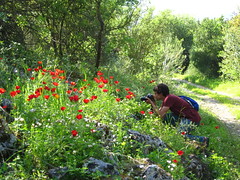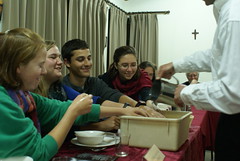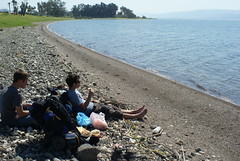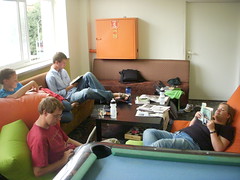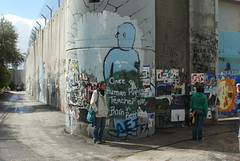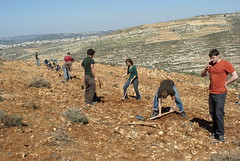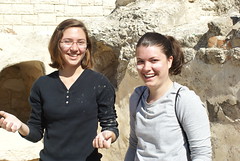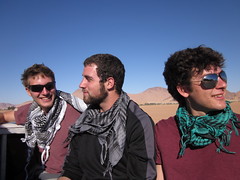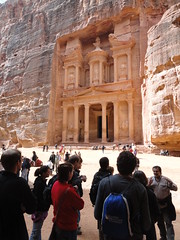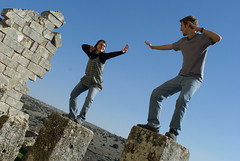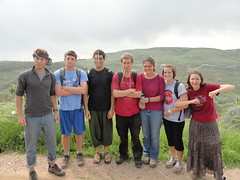 After our week at the kibbutz and at Oranim College, we made our way to the small city of Nazareth for the next stage of our adventure. We are staying in the middle of the old city in a nice hostel with nice people, but then again, when aren’t the people nice here? We spent two days volunteering at Nazareth Village, a small reconstructed village from the first century. When we first visited, we met shepherds, Joseph the carpenter, and Hannah the weaver, all of whom were dressed in handmade first century garments. When we went to volunteer, we found out that we got to dress up too, so we were sent to work on the village wearing a tunic and leather sandals. Most of us had the job of pulling weeds while others got to clean the synagogue area and help prepare the authentic first century meal for tourists. This experience showed us a hint of what the life of Jesus might have been like.
After our week at the kibbutz and at Oranim College, we made our way to the small city of Nazareth for the next stage of our adventure. We are staying in the middle of the old city in a nice hostel with nice people, but then again, when aren’t the people nice here? We spent two days volunteering at Nazareth Village, a small reconstructed village from the first century. When we first visited, we met shepherds, Joseph the carpenter, and Hannah the weaver, all of whom were dressed in handmade first century garments. When we went to volunteer, we found out that we got to dress up too, so we were sent to work on the village wearing a tunic and leather sandals. Most of us had the job of pulling weeds while others got to clean the synagogue area and help prepare the authentic first century meal for tourists. This experience showed us a hint of what the life of Jesus might have been like.
 After our first two days volunteering at Nazareth Village, it was time to hike the Jesus Trail, a 40 mile trek from Nazareth to Capernaum. Our journey was split into 4 days, all of which would end with wonderful hospitality at our various accommodations that were all completely different. Our first day went through Zippori, a Roman city where Joseph may have worked as a tecton (master builder), Mash’had, which was Jonah’s supposed birthplace, and ended in Cana, where Jesus performed his first miracle. The second day was quite easy as we followed the trail blazes through the countryside. We stayed the night in Ilaniya at a goat farm. Since the day was fairly short, we had some time on the farm to hang out, relax, play games, and do handstands.
After our first two days volunteering at Nazareth Village, it was time to hike the Jesus Trail, a 40 mile trek from Nazareth to Capernaum. Our journey was split into 4 days, all of which would end with wonderful hospitality at our various accommodations that were all completely different. Our first day went through Zippori, a Roman city where Joseph may have worked as a tecton (master builder), Mash’had, which was Jonah’s supposed birthplace, and ended in Cana, where Jesus performed his first miracle. The second day was quite easy as we followed the trail blazes through the countryside. We stayed the night in Ilaniya at a goat farm. Since the day was fairly short, we had some time on the farm to hang out, relax, play games, and do handstands.
The next day was the toughest as it measured to about 15 miles, not counting the few times we got lost. The day consisted of seeing a Roman road, climbing the Horns of Hattim, and heading towards the cliffs of Arbel where we stayed in the luxurious Arbel Bed and Breakfast. The last day consisted of hiking to the top of cliffs and then, of course, hiking down. From the top of the cliffs, we could see where we had been for the past two days, and we could also see our destination, Capernaum, was in reach. Just before we arrived at Capernaum, we climbed halfway up the Mount of Beatitudes where Linford gave us some insight about the Sermon on the Mount and how it related to the land surrounding the Galilee.
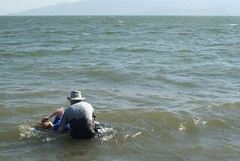 Our journey ended very happily in Capernaum where we celebrated the baptism of Mariah Elliot, where she was immersed in the Sea of Galilee and renewed her commitment to God. This was special for all of us because this is where Jesus called his first disciples and that is where their journey began. As we drove back to Nazareth, we really felt a sense of accomplishment as it took us four days to reach our goal and only took about 45 minutes to drive all the way back. We got to experience the land as Jesus would have, which you do not get on a bus. Now that the Jesus Trail is completed and we are all still in one piece, we have two more days of volunteering in Nazareth Village before we head off to Greece early Wednesday morning. Our journey is quickly coming to a close, and while we are ready to reunite with family and friends, we are also sad to say good bye to the land we have called our home for the past three months.
Our journey ended very happily in Capernaum where we celebrated the baptism of Mariah Elliot, where she was immersed in the Sea of Galilee and renewed her commitment to God. This was special for all of us because this is where Jesus called his first disciples and that is where their journey began. As we drove back to Nazareth, we really felt a sense of accomplishment as it took us four days to reach our goal and only took about 45 minutes to drive all the way back. We got to experience the land as Jesus would have, which you do not get on a bus. Now that the Jesus Trail is completed and we are all still in one piece, we have two more days of volunteering in Nazareth Village before we head off to Greece early Wednesday morning. Our journey is quickly coming to a close, and while we are ready to reunite with family and friends, we are also sad to say good bye to the land we have called our home for the past three months.
-Andre Swartzentruber
